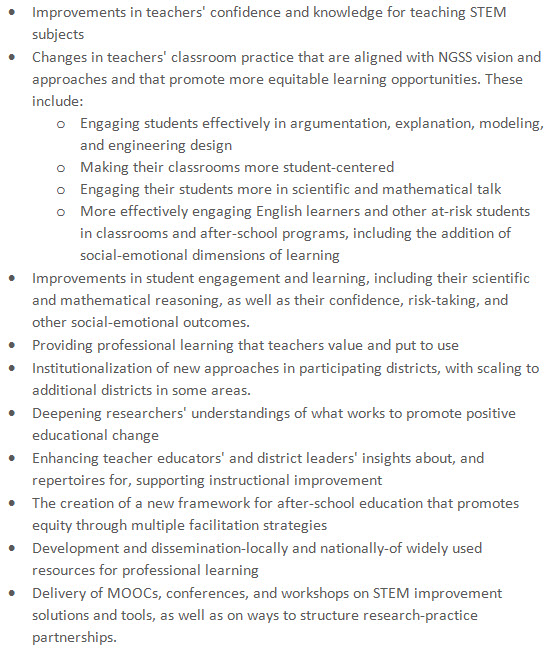Studies of Design and Function in Organizational Arrangements that Link Research and Practice in Education
The Research + Practice Collaboratory (http://researchandpractice.org) was funded for five years by the National Science Foundation to bring research and practice together in effective ways to address core problems of STEM improvement. The five papers in this portfolio examine the design and functioning of the Collaboratory (RPC) from multiple vantage points.
The Collaboratory was formed in response to the problem of the persistent gap between research and practice, a gap that inhibits positive changes in education. In particular, the RPC’s work aimed to demonstrate that research and practice can function in better relationship with one another to better inform educational improvement. To develop this idea, the RPC supported “local labs” in three states — California, Maine, and Washington — each of which focused on an improvement project in STEM.
Each local lab operated as an autonomous research-practice partnership involving local organizations. The types of organizations varied and included universities, school districts, intermediary school reform organizations, and informal/out-of-school organizations. The Collaboratory — led by a team of CoPIs with responsibility for the local labs — also functioned as an over-arching structure that interacted with the labs and the field in a range of ways.
The role of Inverness Research in the Collaboratory was to document and portray the key elements of design that enabled The Collaboratory to serve its mission of enabling research and practice to interact in multiple productive ways for STEM improvement.
For a summary of Collaboratory accomplishments, see below the paper abstracts.
Collaboratories as a Vehicle For Investing in the Improvement of Education: Reflections on the Illuminative Case of the Research+Practice Collaboratory
This paper considers the Research and Practice Collaboratory as an experiment in using the collaboratory structure in the education domain. It discusses the nature and design principles of collaboratories as applied in the sciences, and the adaptation of that structure for use in organizing an educational improvement effort aiming to connect research and practice more productively. The paper outlines the ways in which the collaboratory structure created a connected set of “collaborating laboratories” and sought to optimize the tradeoff between autonomous and collective effort as individual laboratories worked both to promote their own unique efforts as well as contribute to the broader Collaboratory effort.
Cases of the Local Labs
Each local lab functioned as an autonomous effort to address STEM problems of practice, examine solutions, build knowledge, and create resources of value to participating organizations and the field. Each was designed as a research-practice partnership. Inverness Research documented the formation, evolution, and functioning of each partnership as a case, as well as analyzing critical design features the three had in common.
Cross-Case Study
Combining Researchers’ and Practitioners’ Intelligences for STEM Improvement: A Study of the Local Labs of The Research and Practice Collaboratory
Cases of Local Labs
The California Tinkering Afterschool Network (CTAN) brought together practitioners of the Community Science Workshops (Watsonville and Fresno), Discovery Cube (Santa Ana), and Techbridge (Oakland) with educational researchers from the Exploratorium (San Francisco) to design, implement, and study STEM-rich tinkering opportunities in afterschool settings serving traditionally under-served youth.
Education Development Center (EDC) formed Interactive STEM in Maine, a partnership among the Auburn (Maine) School Department, the University of Southern Maine (Portland), and the University of Maine (Farmington) to focus on early grades math learning and the use of technology.
The Washington Partnership for Science and Engineering Practices (PSEP) joined University of Washington researchers with administrators and teachers from the Seattle Public Schools and Renton School District to address problems related to teachers in grades 3-8 shifting their teaching to include NGSS practices.
Accomplishments of the Local Labs
Why so carefully document the design and functioning of the RPC local labs? The initial impetus to do so — with an emphasis on design and functioning — stemmed from the Collaboratory leaders’ idea that research-practice partnerships need to be known about not merely because they are non-traditional, but because they may comprise part of the solution to the long-standing and long-recognized problem of the gap between research and practice, which often manifests as a gap between theory and implementation. In the quest to make research more relevant and valuable to improvement, the forming of partnerships that connect research with practice — that combine the intelligences that span these worlds — can be seen as a rational approach. By documenting how this non-traditional approach works and what it takes, we hope to contribute knowledge to the field.
However, learning about the design is only important if the non-traditional arrangement functions to generate knowledge and practices that have value. Leaders of Local Labs have generated a number of knowledge products, articles, and studies to explain and disseminate the benefits of their work — and the work of the labs continues. Accomplishments that Local Labs have documented include:
Developing the Cases
Data collection for the cases involved the following over the five years of the Collaboratory:
Cases were drafted over time, with member checks conducted for each update.


